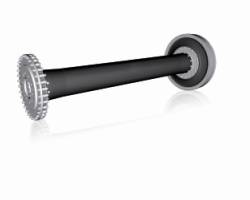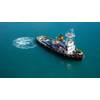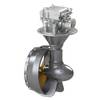New Vulkan Integrated Shaft Coupling Design
VULKAN Couplings recently introduced a unique combination of the proven RATO DS coupling with a directly connected Composite shaft. The high radial stiffness and the comparably low axial and bending stiffness makes the RATO DS suitable to work not only as a torsional coupling but also as an integrated misalignment coupling when rigidly connected to an intermediate shaft. At the rear end of the intermediate shaft a torsionally stiff misalignment coupling creates the second bending flexible pivot thus providing a double cardanic design. This new combination consisting of RATO DS and intermediate shaft is called VULKAN Integrated Shaft Coupling (ISC).
It was found that the angular deflection of the RATO DS causes – even at high misalignment levels – a rather low strain level compared to the torque load and thus a low power loss. Therefore no misalignment coupling is required between RATO DS and shaft. The intermediate shaft can be directly connected to the inner ring of the coupling whereby the RATO DS is radially not supported. The mass of the intermediate shaft is limited by the radial natural frequency of half the shaft and the inner part of the RATO DS. The design radial natural frequency is selected not to be less than 120% of design rpm. In most cases a light weight VULKAN Composite shaft will be the preferred solution for the intermediate shaft. In order to get a double cardanic design the intermediate shaft is connected at the rear end to a steel membrane or a METAFLEX coupling.
The advantages of the new ISC design are a significant reduction of parts, bearing less design and weight saving. This leads to reduced installation and alignment efforts. Moreover with the ISC design there is no noise transmission path over metallic or bearing parts between engine and gearbox. The ISC provides excellent sound isolation against structure borne noise due to the RATO DS rubber element. The combination of the torsional compliance of the RATO DS together with the torsional compliance of the Composite shaft results in an advantageous torsional system which leads to a reduction of the vibratory torque in all parts of the drive train. Depending on the shaft speed the ISC design based on RATO DS can be combined with Composite shafts up to 7 m length. All RATO DS coupling elements whether single row or dual couplings can be used for the ISC design.
Source: www.vulkan.com














